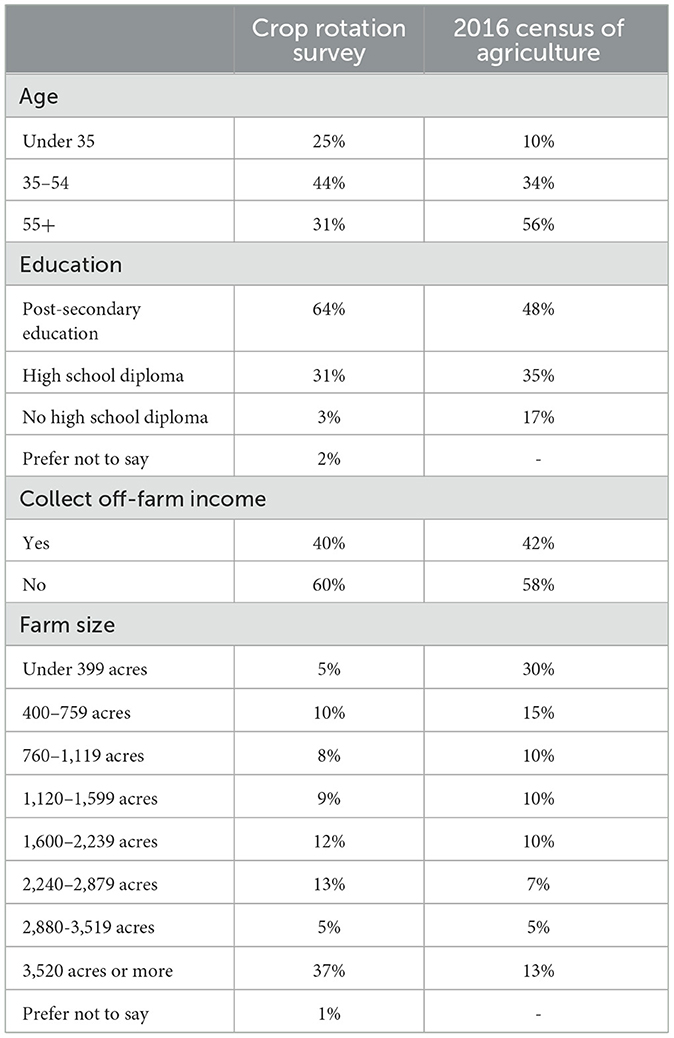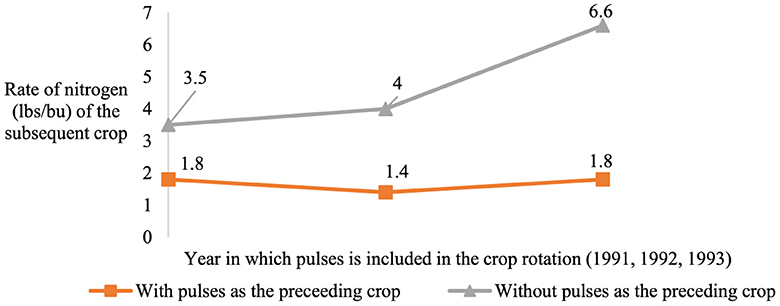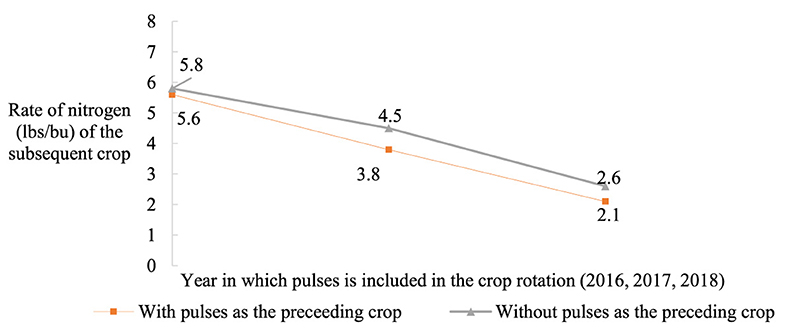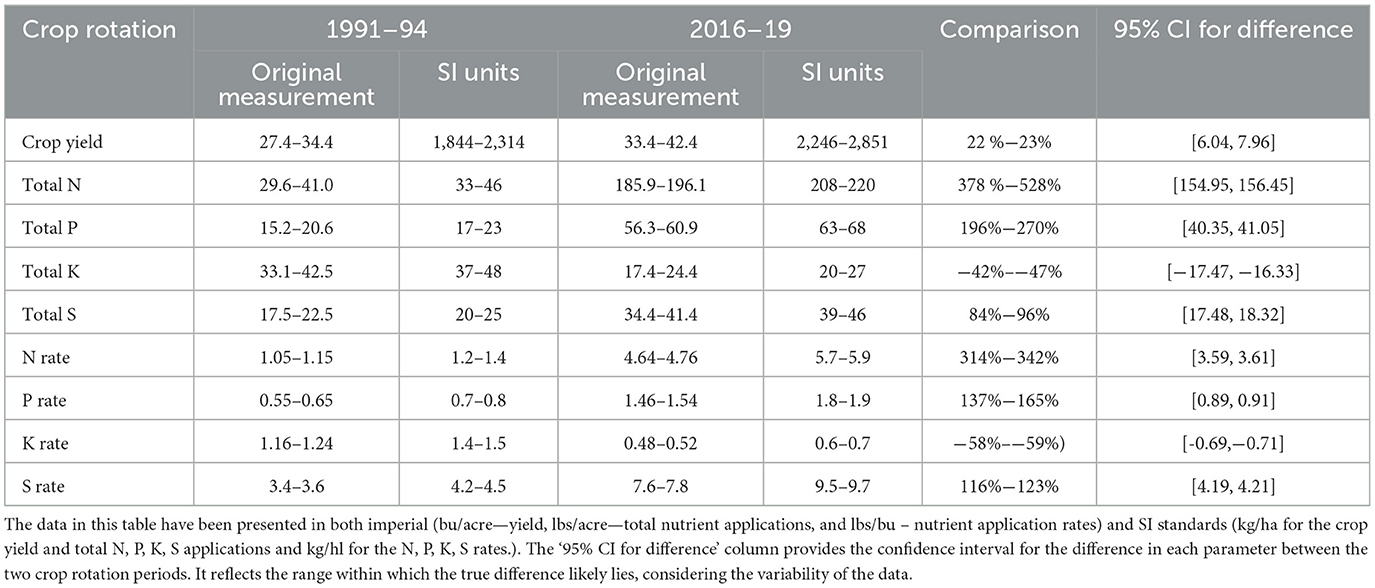- Department of Agricultural and Resource Economics, University of Saskatchewan, Saskatoon, SK, Canada
Introduction: Over the last three decades, Saskatchewan, home to over 40% of Canada's cropland, has seen transformative shifts in dryland crop production. Notably, the adoption of herbicide-tolerant canola in 1995 and the increase in nitrogen-fixing pulse crops like lentils and chickpeas have moved agricultural practices away from traditional fallow and tilled fields to more continuous crop rotations.
Methods: Our study, analyzing survey data from 1991–1994 and to 2016–2019, evaluates how these changes have influenced fertilizer usage, focusing on application rates, timing, and types.
Results: We anticipated that integrating nitrogen-fixing pulses and genetically modified herbicide-tolerant (GMHT) canola would promote more sustainable fertilization methods. Indeed, our results show significant reductions in nitrogen fertilizer use - by 49% to 73% in the earlier period and 3% to 19% more recently - due to the integration of these crops.
Discussion: GMHT canola, by reducing the dependency on synthetic nitrogen fertilizers, demonstrates a shift in fertility dynamics by enhancing nutrient uptake efficiency. This adaptation has not only reduced fertilizer costs but also contributed to more sustainable crop management. These findings highlight the environmental benefits of updated crop rotations, emphasizing the improved efficiency of fertilizer use. More broadly, they highlight the potential of expanded pulse cultivation to boost agricultural sustainability and reduce greenhouse gas emissions through better nitrogen management. While the transferability of these findings may be limited by the study's regional focus and sample size, they hold value for informing sustainable practices in similar agricultural settings.
1 Introduction
Technological advancements and innovations have markedly transformed crop production across the Canadian prairies in the last 30 years, underlining the critical need to reconcile increasing food production demands with environmental sustainability imperatives such as reducing greenhouse gas (GHG) emissions, minimizing water usage, and preserving soil health (Lassoued et al., 2023). This transformation is particularly evident in Saskatchewan, where the adoption of herbicide-tolerant crops, notably genetically modified herbicide-tolerant (GMHT) canola (Brassica napus L.), has shifted weed control strategies from traditional summerfallow practices-leaving fields unplanted to manage weeds-to more sustainable methods. This shift is corroborated by research, including Sutherland et al. (2021), and is further supported by advancements in seeding technology, such as variable rate application and precision seeding, marking significant strides toward achieving agricultural sustainability (Li et al., 2022; Xu et al., 2024).
This progression in agricultural practices, while reflecting a broader global trend toward environmentally responsible farming, also brings to the forefront the challenges associated with implementing environmental mandates based on empirical evidence. The European Union's Farm to Fork Strategy, aimed at significantly reducing pesticide and fertilizer use, exemplifies these challenges. Critiques, such as Wesseler (2022), have highlighted that the ambitious targets of this strategy are set without a solid empirical foundation, which could lead to economic inefficiencies and possibly fail to achieve the intended environmental benefits.
Furthermore, the initial targets set by Environment and Climate Change Canada (ECCC) for a 30% reduction in nitrous oxide emissions from agricultural fertilizers by 2030 faced similar challenges. Originally lacking empirical justification, these targets were subsequently adjusted to a voluntary status following feedback from the agricultural industry, as discussed by Baumergarten (2022). Such instances highlight the importance of basing environmental mandates on robust, research-driven data to ensure their efficacy and sustainability.
Our research aims to fill this empirical gap by analyzing data from a comprehensive survey of Saskatchewan crop producers, conducted from November 2020 to April 2021. This survey focused on changes in agricultural practices, particularly in fertilizer use, during two different four-year crop rotation periods. It covered a range of practices from seedbed preparation to chemical applications, providing a robust dataset to assess shifts toward more sustainable practices over nearly three decades. By analyzing survey data, this study contributes to understanding the potential benefits of integrating nitrogen-fixing pulse crops and GMHT canola into crop rotations. The findings offer practical insights that could inform agricultural practices aimed at enhancing sustainability, thereby helping to refine the balance between increased food production and environmental conservation strategies.
The projected increase in global population to 9.7 billion by 2050 and 10.4 billion by 2100 (United Nations, 2022) underscores the escalating demand for food, placing significant pressure on Canadian agriculture to sustainably increase production of key crops such as wheat, canola, and pulses. This challenge is compounded by the environmental repercussions of using high levels of fertilizers and pesticides in crop production, a necessity driven by the shift away from traditional summerfallow methods to continuous crop production (Zhang et al., 2015; Hauggaard-Nielsen et al., 2016; Seitzinger and Phillips, 2017). The volatility of fertilizer costs has also spurred interest in sustainable alternatives.
In response, the incorporation of nitrogen-fixing pulse crops (e.g., lentils, dry peas, chickpeas) into crop rotations has emerged as a viable strategy for enhancing crop yields while mitigating environmental impacts and reducing fertilizer expenses by up to 37% (Gan et al., 2015; St. Luce et al., 2015; Khakbazan et al., 2022). Pulses play a pivotal role in nitrogen cycling, capturing atmospheric nitrogen through symbiosis with rhizobia bacteria in their root nodules, thereby enriching the soil with bioavailable nitrogen. This process reduces reliance on synthetic fertilizers and boosts soil health by enhancing organic matter and improving soil structure (Hossain et al., 2016; Schoenau, 2016). Such biological contributions of pulses to soil ecosystems underscore their importance in sustainable agricultural practices (Huang et al., 2023; Qiu et al., 2023). However, integrating nitrogen-fixing pulse crops into crop rotations also comes with challenges such as impacts on soil microbial communities and the potential for host-specific pathogens, which can alter microbial diversity and function (Yang et al., 2021). Additionally, the nitrogen released from pulse residues may not always align with the subsequent crops' needs, leading to potential nitrogen losses. Effective incorporation of pulses requires careful management to balance their ecological and economic benefits while addressing these issues.
Research within Canada corroborates the beneficial impacts of pulse cultivation on the nitrogen needs and yields of following crops (MacWilliam et al., 2014; St. Luce et al., 2015; Chen, 2016), demonstrating the economic and environmental advantages of integrating pulses into crop rotations. For instance, Khakbazan et al. (2014) found that including pulses in crop rotations was the most profitable because of both the positive contribution to the yield of the subsequent crop and the reduction of the amount of nitrogen applied the following year. Generally, the net return was maximized between 60 and 90 kilograms per hectare (53–80 lbs/acre) of nitrogen applied.
Saskatchewan's agricultural evolution has significantly impacted both national and global food systems. According to Phillips and Fransoo (2022), Saskatchewan farmers produce 95% of Canada's lentils, 99% of its chickpeas, and a substantial portion of dry peas. In 2016, the province saw record cultivation levels with 2.08 million hectares allocated to lentils and 1.73 million hectares to peas, reflecting increases of 30% and 16%, respectively, compared to the previous year (Agriculture Agri-Food Canada, 2021; Statistics Canada, 2022). Saskatchewan's role in pulse exports is highlighted by its 65% share in global lentil exports and 55% in pea exports (Saskatchewan Advantage, 2021). Despite a challenging drought in 2021 that reduced production volumes, Saskatchewan remained Canada's predominant pulse producer. Figures 1, 2 illustrate the annual production volumes of dry peas and lentils in Saskatchewan.

Figure 1. Saskatchewan annual dry pea production. Source: Saskatchewan Advantage (2021).

Figure 2. Saskatchewan annual lentil production. Source: Saskatchewan Advantage (2021).
The development of canola from traditional rapeseed through selective breeding during the 1970s in Canada represents a major advancement in agriculture. This effort produced an oilseed with lower levels of erucic acid and glucosinolates, making it more suitable for human consumption and offering a better flavor compared to traditional rapeseed. The name “canola” derives from “Canadian oil, low acid.” Through techniques like crossbreeding, mutation breeding, and genomic selection, canola has become a key crop in modern agriculture (Bayer Crop Science, 2022).
The introduction of GMHT canola varieties in 1995 significantly increased Canadian canola production. According to Agriculture Agri-Food Canada (2022), canola outputs have tripled since then, reaching about 19.5 million tons by the 2020–2021 crop year. Most of this production comes from Saskatchewan, Alberta, and Manitoba, with Saskatchewan accounting for a significant share of global canola seed exports (Saskatchewan Advantage, 2021) (Figure 3).
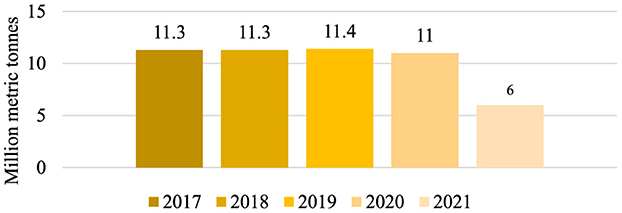
Figure 3. Saskatchewan annual canola seed production. Source: Saskatchewan Advantage (2021).
The widespread adoption of GMHT canola varieties is evidenced by the increase in canola acreage (Stringam et al., 2003). Following unrestricted commercial production in 1997, adoption was swift, reaching 25% in the initial year, 84% by 2002, and 98% by 2007 (Gusta et al., 2011). The total area cultivated with canola increased by 31% to an average of 5.6 million hectares (13.9 million acres) from 2003 to 2008, compared to 4.2 million hectares (10.5 million acres) from 1991 to 1995 (Statistics Canada, 2008). This shift not only facilitated better weed control (Shaw, 2014), reducing the need for tillage and thus lessening soil erosion and conserving moisture (Gusta et al., 2011), but also improved yield and input use efficiency between 1990 and 2010 (MacWilliam et al., 2016).
Moreover, GMHT canola varieties have provided significant benefits to farmers. Smyth et al. (2010) estimate that GMHT canola has delivered great economic benefits to Western Canada farmers, with annual net gains between $1.063 billion and $ 1.192 billion. It also improved weed control, reduced herbicide toxicity, and minimized chemical exposure. Furthermore, GMHT canola promoted better soil conservation through reduced tillage practices, underscoring its role in enhancing both economic and environmental sustainability in Western Canadian agriculture (Smyth et al., 2010).
However, the widespread use of herbicide-tolerant (HT) crops has also sparked concerns about the potential for increased weed resistance and its impact on biodiversity, issues that Mortensen et al. (2012) and Beckie et al. (2013) have explored. While this study offers insights into sustainable agricultural practices, it does not address the potential consequences of HT crops on weed resistance and biodiversity, an area recommended for further investigation to fully understand the implications of HT crop usage.
2 Materials and methods
This research draws on data from a Saskatchewan crop farmer online survey conducted between November 2020 to April 2021, aimed at assessing changes in agricultural practices during the four-year crop rotation periods of 1991–1994 and 2016–2019. The survey targeted evaluations of fertilizer use across cereal, pulse, and oilseed crops to understand the longitudinal impact of agronomic transitions, such as the adoption of GMHT canola and increased use of nitrogen-fixing pulse crops. The analysis focuses on the shifts in fertilizer requirements resulting from the inclusion of pulses in crop rotations, the implications of GMHT canola on farming methods, and the correlation between these practices and the yield outcomes of subsequent crops. Respondents provided detailed information on their agricultural activities, including crop type, varieties planted, and fertilizer application metrics from initial seeding to post-harvest across both time periods. However, only first-pass application data were considered for analysis to ensure consistency, as subsequent data were either sparse or unavailable.
The survey was structured into four sections:
1. Seedbed preparation, planting and harvest practices which explored the techniques, equipment and inputs employed from the planting stage to the harvest.
2. Fertilizer use section which documented the application rates, methods and timings of fertilizer use, crucial for understanding changes in nutrient management strategies.
3. Tillage and summer fallow practices section which examined the frequency of tillage, the depth of tillage and the implements used, providing insight into soil management practices.
4. Chemical applications section which focused on the use of chemicals, including the types, timings, rates, and equipment used.
The inclusion of various agricultural practices, from seedbed preparation to chemical applications, allows for a nuanced understanding of how the evolution of farming strategies and their implications for sustainability. This method allows us to assess the impact of crop choices, like the increased use of nitrogen-fixing pulses and GMHT canola, on the sustainability of agricultural ecosystems, highlighting shifts toward more environmentally friendly practices.
While the survey also included an attribution questionnaire to assess the perceived impacts of HT crops, GM crops and glyphosate on conservation tillage and summerfallow reduction, responses from this component were not analyzed for this particular study and are beyond its scope. This section aimed to understand farmers' perceptions of technology influences on sustainable practices. In aligning with rigorous academic standards, the University of Saskatchewan's Research Ethics Board granted an exemption for ethics approval, as the survey only involved data without personal identifiers.
Farmers were instructed to complete the survey for a single field, as long as it was used for the production of conventional, genetically modified or organic crops. When possible, participants were asked to report on the same field for both the 1991–1994 and 2016–2019 time periods. This approach allowed for a consistent and comparative analysis of practices over time. To incentive farmers to complete the survey, farmers received up to $200 for completing the entire survey. This financial remuneration was a token amount, as the average survey response time was 3–5 h.
Data cleaning and analysis were conducted using Excel and R software, transforming raw data into a format suitable for comprehensive analysis. This included quantifying fertilizer applications in terms of elemental content (kilograms of nitrogen per hectare) and ensuring consistency across data points. Outliers, specifically identified as observations with extremely high values of seedable acres and fertilizer rates, were removed based on statistical thresholds significantly deviating from the mean. We also removed duplicate entries, responses from those who did not farm in both the 1991–1994 and 2016–2019 periods, and incomplete or incorrect responses. To ensure alignment with international research standards, all units were converted following guidelines recommended by the International System of Units (SI). For example, field area measurements were converted from acres to hectares, and fertilizer applications from pounds per acre to kilograms per hectare, facilitating comparability with global data. Crop yield data was converted from pounds per acre, tons per acre, or bushels per acre to kilograms per hectare, utilizing conversion factors tailored to the specific weights of different crop types.
While all respondents who received a link to the online survey completed portions of it, the extent of completion varied among participants, with some providing more comprehensive responses than others across different questions and sections. Originally, the Saskatchewan farmer dataset included 160 participants. Survey participants were located across the province with relatively even distribution. The highest number of participants in the full sample were located in the Northwest region of the province, and the fewest in the Southcentral region. For the subset selection, of the original 160 participants, 69 were chosen based on rigorous criteria to ensure data integrity and comparability. This included requirements such as active farming in both the 1991–1994 and 2016–2019 periods, complete and consistent data across all survey sections, and exclusion of respondents with implausibly high elemental components (N, P, K, S), exceeding total fertilizer amounts were excluded.
Our survey's relatively small participant group necessitated a comparison with external data sources to verify its representatives of Saskatchewan's farming population. When compared to the 2016 Canadian Census of Agriculture data for Saskatchewan (Statistics Canada, 2017), our survey participants tended to be younger, more educated and manage larger farms. This trend could be attributed to the likelihood of more educated farmers showing greater interest in academic surveys. Additionally, the younger demographic may have been more inclined to participate in an online survey format. Despite these differences, our sample broadly reflects the demographic composition of Saskatchewan's composition of Saskatchewan's farming community, providing a robust basis for our analysis. Table 1 provides more detailed information on the demographics of the full survey sample.
Our approach combined descriptive and inferential statistical methods to extract meaningful patterns from the data. Descriptive statistics, including means, medians, and ranges, provided an initial overview of key variables like nitrogen rates, crop yields, and elemental fertilizer components. Subsequently, two-way ANOVA (Analysis of Variance) was applied to discern the impact of crop type and rotation period on these metrics, appreciating both individual and interactive effects. We chose two-way ANOVA because it allows for the examination of the effects of both crop type and rotation period, as well as how these factors interact with each other. This method allows for the visualization of the bigger picture of how different variables affect agricultural outcomes.
Further, t-tests were conducted to examine potential variations more closely and make comparisons. For instance, where ANOVA suggested potential variations in nitrogen requirements due to the inclusion of pulses in crop rotations, t-tests were applied to assess these differences for subsequent non-pulse crops. Similarly, t-tests were also used to compare yields of cereal crops following pulse cultivation and to evaluate shifts in elemental fertilizer components for pulses and canola types across the two periods. Additionally, we used t-tests to explore the variations in fertilizer application practices between conventional canola and the GMHT canola over the two crop rotation periods.
We introduced two principal metrics to evaluate fertilizer usage effectively: total nutrient application expressed in pounds per acre (original measurement) and nutrient rates per unit of crop yield expressed in pounds per bushel (original measurement). The former metric reflects the absolute quantity of nutrients applied to the land, providing a direct measure of fertilizer intensity and changes in fertilization practices over the study period. In contrast, the second metric, which we refer to as N, P, K, S rates, offers insights into the efficiency of fertilizer use relative to crop yield, indicating how effectively these nutrients contribute to crop production. Throughout the article, we use these metrics to assess both the changes in overall fertilizer use and the improvements in fertilizer use efficiency over time.
It is important to recognize potential biases due to the reliance on self-reported data, which might lead to inaccuracies in describing farming practices. Additionally, the study's focus on active farmers limits its generalizability across all agricultural demographics. Moreover, while the data provides insights into the agricultural dynamics of Saskatchewan, it is influenced by specific regional practices and conditions. These factors should be considered when interpreting the results and extrapolating them to broader agricultural contexts.
3 Results
Our study focused on the integration of nitrogen-fixing pulse crops and GMHT canola in Saskatchewan's agricultural practices. Notably, the percentage of respondents including pulses at least once in their four-year crop rotation increased from 40% in 1991–94 to 50% in 2016–19, with a 95% confidence interval of −3.72% to 23.72%. This period also saw a slight increase in the frequency of using pulses as a preceding crop in rotations. Of farmers that have included pulses in the rotation, 17% have planted pulse crops twice in their four-year crop rotation period.
The research quantified how diversification in crop rotations influenced nitrogen application rates. In both crop rotation periods, the nitrogen rate applied to crops following pulse cultivation was significantly lower. For the 1991–1994 period, rates were 49% to 73% lower, with a confidence interval for this reduction from 59.82% to 62.18% (Figure 4). For the 2016–2019 period, the reduction was between 3% and 19%, with a similar confidence interval (Figure 5). A statistical test to ascertain the significance of these differences yielded a t-statistic of ~3.47, with a confidence interval of 2.01 to 4.93. The associated p-value was ~0.074, indicating a notable difference in nitrogen rates between the two periods, although not reaching conventional statistical significance.
An analysis of cereal crop yields following pulse crops revealed variability in yield outcomes across different years. Notable yield increases were observed in 1994 and 2017, with a significant decrease in 2018 (Table 2). These observations are presented without interpreting the agronomic or environmental factors that might influence yield variations. Many parts of Saskatchewan experienced below-average rainfall levels in 2018, which may have contributed to the abnormal yield results.
A t-test comparing the yields of cereal crops preceded by a pulse crop vs. those not preceded by a pulse crop resulted in a t-statistic of ~1.124, with an associated p-value of about 0.287. This statistical result in presented without further interpretation regarding the significance of the impact on yield.
Further analysis of elemental fertilizer components and crop yields for pulses was conducted for the two periods. Except for potassium, which showed a decrease, applications of nitrogen, phosphorus, and sulfur per bushel of crop yield increased in the 2016–2019 period compared to the previous period. Crop yields also increased by almost 23% across the two periods (Table 3). The t-test yielded a t-test statistic of (−1.1415) and an associated p-value of 0.2704, which indicates the differences in elemental fertilizer components for pulses between the two periods are not statistically significant. Soil testing among farmers who planted pulses indicated that 40% to 60% sampled their soil, with the majority (80%−100%) noting an increase in soil fertility.
Our analysis included a comparison of fertilizer application rates per bushel of crop yield among pulses, oilseed, and cereal crops (Table 4). The results indicated that pulses typically required less or comparable amounts of nitrogen and phosphorus per bushel of crop yield compared to oilseed and cereal crops. Additionally, an ANOVA was conducted to assess the effect of different crop types on the application of rates of N, P, K, S. The results of this analysis showed no statistically significant differences in the NPKS rates among pulses, oilseed, and cereal crops, with p-values of 0.538 and 0.465 for the 1991–1994 and 2016–2019 periods, respectively.
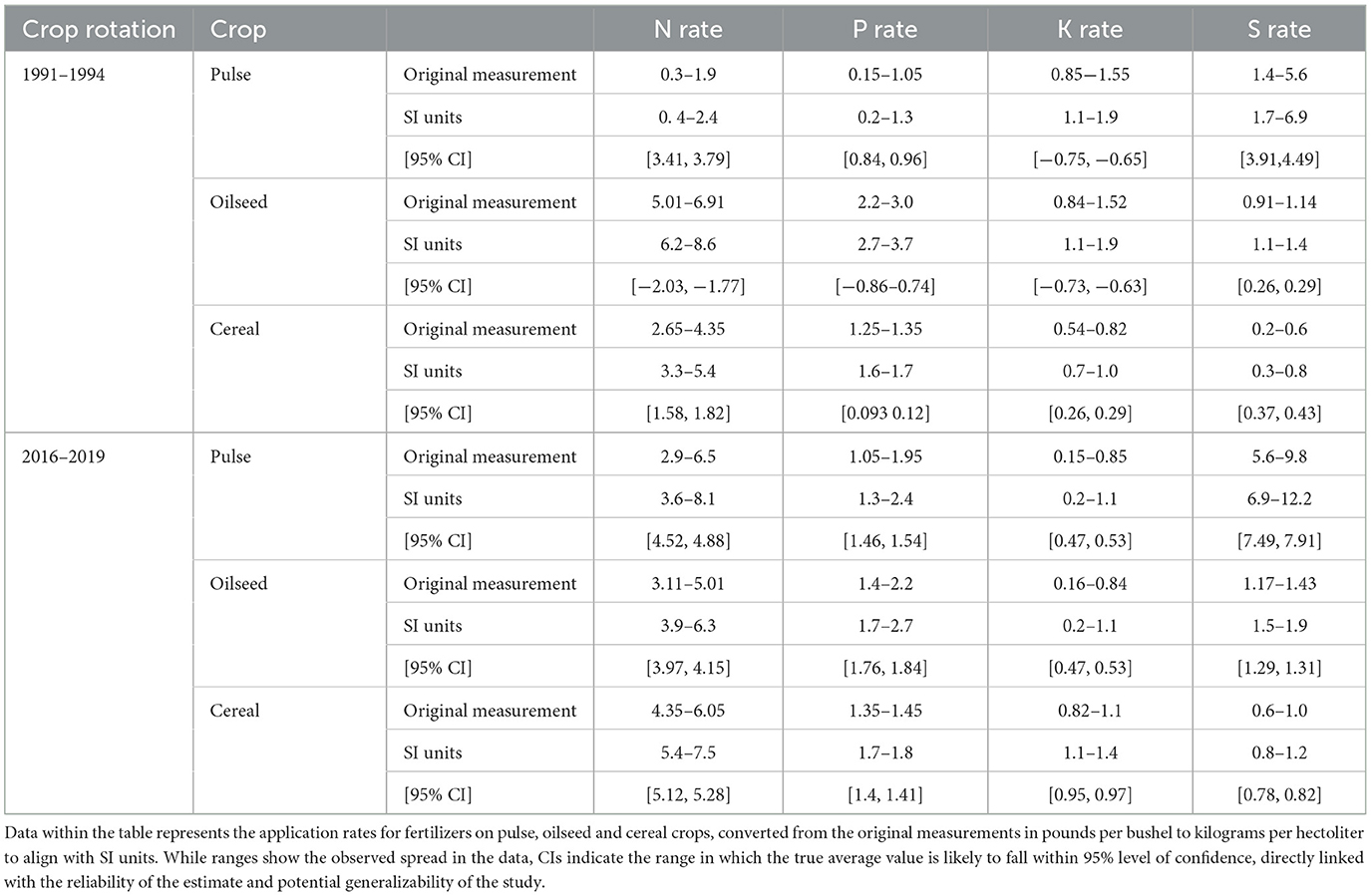
Table 4. Comparative analysis of fertilizer application rates for pulses compared to oilseed and cereal crops across the two crop rotation periods.
In response to substantial increases in canola acreage and changes in management practices for canola production in Saskatchewan, we examined the shifts in fertilizer application rates between conventional canola during 1991–1994 and GMHT canola during 2016–2019. The analysis found that farmers applied fewer pounds of nitrogen, phosphorus, and potassium per bushel of GMHT canola yield in the later period compared to the earlier period. Specifically, potassium application rates experienced the largest decrease, falling by 58%. Concurrently, the yield of GMHT canola nearly doubled in the second rotation period (Table 5).
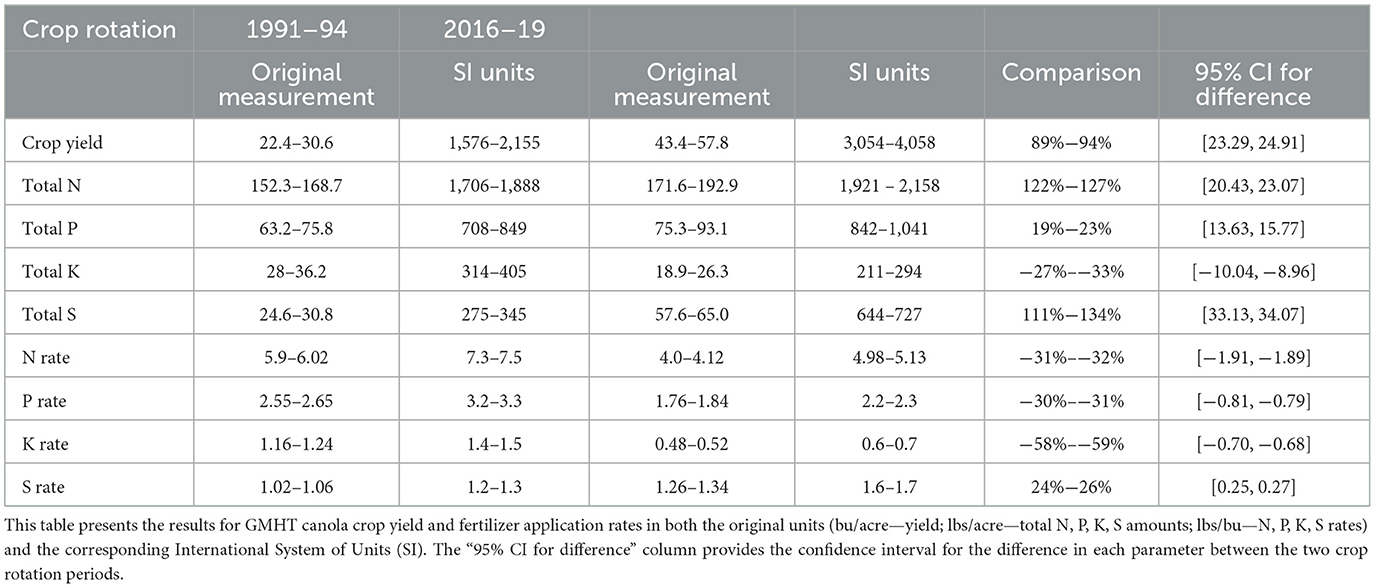
Table 5. Fertilizer application and crop yield for GMHT canola: comparative ranges between the two periods.
A t-test was conducted to evaluate the differences in elemental fertilizer components between conventional and GMHT canola across the two periods. The test yielded a t-statistic of −0.3444 and associated p-value of 0.7351, suggesting that the differences in fertilizer components between the two types of canola were not statistically significant.
The study quantified the changes in nitrogen application rates and examined the efficiency of fertilizer use associated with the integration of nitrogen-fixing pulse crops and GMHT canola in Saskatchewan. Findings indicate a reduction in nitrogen, phosphorus, and potassium application per bushel for GMHT canola compared to conventional canola, alongside an increase in yield. Additionally, the integration of pulse crops was associated with decreased nitrogen application rates, supporting their role in enhancing the nitrogen efficiency of subsequent crops.
4 Discussion
Our research investigated the impact of integrating nitrogen-fixing pulse crops and adopting genetically modified herbicide-tolerant (GMHT) canola on fertilizer use patterns in Saskatchewan. This integration has significantly influenced these patterns, showcasing the interplay between evolving agricultural practices and environmental impacts. This study underscores the role of innovative practices in achieving productivity alongside sustainability, essential for addressing global agricultural challenges.
4.1 Innovative practices and environmental sustainability
The inclusion of nitrogen-fixing pulses led to a notable reduction in nitrogen fertilizer requirements, affirming their role in sustainable agriculture by lessening reliance on synthetic fertilizers. This outcome aligns with global sustainability goals, such as reducing GHG emissions and enhancing soil health (Kumar et al., 2023; Government of Saskatchewan, n.d.). Moreover, the utilization of GMHT canola resulted in reduced usage of nitrogen, phosphorus, and potassium fertilizers compared to conventional varieties, highlighting the benefits of GMHT crops in enhancing input efficiency.
These findings advocate for a shift toward more diverse and sustainable rotations, enhancing sustainable agriculture by lessening reliance on synthetic fertilizers (Zhang et al., 2023). Such practices, when supported by policy measures that encourage the adoption of GMHT canola and nitrogen-fixing pulses, could significantly contribute to agricultural sustainability targets. This approach reflects a commitment to balancing productivity with environmental preservation and offers a model for sustainable agricultural intensification.
4.2 Implications beyond Saskatchewan
While this study focuses on Saskatchewan, the insights offer broader lessons on optimizing resource use and minimizing environmental impacts in agriculture globally. The integration of sustainable practices aligns with the United Nations' Sustainable Development Goals, especially Zero Hunger (SDG 2) and Life on Land (SDG 15). The practices demonstrated by Saskatchewan's grain farmers could potentially enhance agricultural sustainability worldwide.
From a farmer's perspective, the changes in nitrogen application have important implications. Reduced nitrogen use can lead to direct cost savings on fertilizers, thereby enhancing on-farm profitability (Khakbazan et al., 2022). More efficient fertilizer use also contributes to better soil health and reduces the risk of environmental degradation from overuse of inputs (MacWilliam et al., 2018). Additionally, the shift toward integrating pulses into crop rotations represents a practical benefit that can lead to more economically and environmentally sustainable farming practices. Identified differences between crop rotations with and without pulses as the preceding crop highlight the value of managing fertilizer use efficiently in commercial agriculture where there is often an overuse of fertilizers.
However, our study, while comprehensive, is not without limitations. The sample size and geographic focus may restrict the generalizability of the findings. Future research should aim to include a broader array of environments and crops systems to extend our findings. Moreover, long-term studies could help elucidate the persistent effects of these agronomic practices on soil health and crop yields.
5 Conclusion
The results of this research illustrate how Saskatchewan's grain farmers are leading in the efficient use of fertilizers, contributing to the development of sustainable agricultural systems. By fostering increased investment in nutrient use efficiency, rather than mandating reductions in fertilizer use, we can enhance the sustainability of crop production. As the agricultural sector moves toward achieving global sustainability goals, the practices highlighted in this study emphasize the importance of innovation and adaptability in agriculture. This research contributes to the ongoing dialogue on sustainable agriculture, underlining the need for continued investigation and collaboration among stakeholders to achieve food security and environmental sustainability.
Data availability statement
The raw data supporting the conclusions of this article will be made available by the authors, without undue reservation.
Author contributions
EL: Formal analysis, Visualization, Writing – original draft, Writing – review & editing. CS: Data curation, Writing – original draft, Writing – review & editing. SG: Conceptualization, Data curation, Methodology, Project administration, Supervision, Writing – review & editing. SS: Conceptualization, Funding acquisition, Supervision, Writing – original draft, Writing – review & editing.
Funding
The author(s) declare that financial support was received for the research, authorship, and/or publication of this article. This research was funded through the Canada First Research Excellence Fund (CFREF) grant that established the Plant Phenotyping and Imaging Research Center (P2IRC) project.
Conflict of interest
The authors declare that the research was conducted in the absence of any commercial or financial relationships that could be construed as a potential conflict of interest.
The author(s) declared that they were an editorial board member of Frontiers, at the time of submission. This had no impact on the peer review process and the final decision.
Publisher's note
All claims expressed in this article are solely those of the authors and do not necessarily represent those of their affiliated organizations, or those of the publisher, the editors and the reviewers. Any product that may be evaluated in this article, or claim that may be made by its manufacturer, is not guaranteed or endorsed by the publisher.
References
Agriculture and Agri-Food Canada (2021). Canada: Outlook for Principal Field Crops. Available online at: https://publications.gc.ca/collections/collection_2021/aac-aafc/A77-1-2021-5-20-eng.pdf (accessed November 27, 2023).
Agriculture and Agri-Food Canada (2022). “Reports and statistics data for Canadian Principal Field Crops,” in Historical Data. Available online at: https://agriculture.canada.ca/en/market-information-system/rp/index-eng.cfm?action=pR&r=243&pdctc (accessed February 1, 2024).
Baumergarten, S. (2022). Canada's Plan to Cut Emissions Is Voluntary - Minister. Available online at: https://www.icis.com/explore/resources/news/2022/08/19/10797681/canada-s-plan-to-cut-fertilizer-emissions-is-voluntary-minister/ (accessed February 5, 2024).
Bayer Crop Science (2022). Canola Breeding Process. Available online at: from https://www.cropscience.bayer.ca/en/articles/2022/canola-breeding-process (accessed November 27, 2023).
Beckie, H. J., Blackshaw, R. E., Low, R., Hall, L. M., Sauder, C. A., Martin, S., et al. (2013). Glyphosate- and acetolactate synthase inhibitor–resistant kochia (Kochia scoparia) in Western Canada. Weed Sci. 61, 310–318. doi: 10.1614/WS-D-12-00140.1
Chen, C. (2016). Rotation Effect of Pulse Crops on Nitrogen Fixation and Carbon Input to Soil. Saskatoon: University of Saskatchewan.
Gan, Y., Hamel, C., O'Donovan, J. T., Cutforth, H., Zentner, R. P., Campbell, C. A., et al. (2015). Diversifying crop rotations with pulses enhances system productivity. Sci. Rep. 5:14625. doi: 10.1038/srep14625
Government of Saskatchewan (n.d.). Inoculation of Pulse Crops, Soils, Fertility and Nutrients. Available online at: https://www.saskatchewan.ca/business/agriculture-natural-resources-and-industry/agribusiness-farmers-and-ranchers/crops-and-irrigation/soils-fertility-and-nutrients/inoculation-of-pulse-crops (accessed November 29, 2023).
Gusta, M., Smyth, S. J., Belcher, K., Phillips, P. W. B., and Castle, D. (2011). Economic benefits of genetically-modified herbicide-tolerant canola for producers. AgBioForum 14:1−13.
Hauggaard-Nielsen, H., Lachouani, P., Knudsen, M. T., Ambus, P., Boelt, B., and Gislum, R. (2016). Productivity and carbon footprint of perennial grass–forage legume intercropping strategies with high or low nitrogen fertilizer input. Sci. Total Environm. 541, 1339–1347. doi: 10.1016/j.scitotenv.2015.10.013
Hossain, Z., Wang, X., Hamel, C., Diane Knight, J., Morrison, M. J., and Gan, Y. (2016). Biological nitrogen fixation by pulse crops on semiarid Canadian Prairies. Can. J. Plant Sci. 97, 119–131. doi: 10.1139/CJPS-2016-0185
Huang, H., Huang, J., Wu, Y., Zhuo, W., Song, J., Li, X., et al. (2023). the improved winter wheat yield estimation by assimilating GLASS LAI into a crop growth model with the proposed bayesian posterior-based ensemble Kalman filter. IEEE Trans. Geosci. Remote Sens. 61:3259742. doi: 10.1109/TGRS.2023.3259742
Khakbazan, M., Grant, C. A., Huang, J., Smith, E. G., O'donovan, J. T., Blackshaw, R. E., et al. (2014). Economic effects of preceding crops and nitrogen application on Canola and subsequent barley. Agron. J. 106, 2055–2066. doi: 10.2134/agronj14.0253
Khakbazan, M., Liu, K., Bandara, M., Huang, J., and Gan, Y. (2022). Pulse-included diverse crop rotations improved the systems economic profitability: evidenced in two 4-year cycles of rotation experiments. Agron. Sustain. Dev. 42:5. doi: 10.1007/s13593-022-00831-2
Kumar, S., Gopinath, K. A., Sheoran, S., Meena, R. S., Srinivasarao, C., Bedwal, S., et al. (2023). Pulse-based cropping systems for soil health restoration, resources conservation, and nutritional and environmental security in rainfed agroecosystems. Front. Microbiol. 13:1041124. doi: 10.3389/fmicb.2022.1041124
Lassoued, R., Phillips, P. W. B., and Smyth, S. J. (2023). Exploratory analysis on drivers and barriers to Canadian prairie agricultural technology and adoption. Smart Agricult. Technol. 5:100257. doi.org/10.1016/j.atech.2023.100257
Li, H., Zhang, T., Shaheen, S. M., Abdelrahman, H., Ali, E. F., Bolan, N. S., et al. (2022). Microbial inoculants and struvite improved organic matter humification and stabilized phosphorus during swine manure composting: multivariate and multiscale investigations. Bioresour. Technol. 351:126976. doi: 10.1016/j.biortech.2022.126976
MacWilliam, S., Parker, D., Marinangeli, C. P. F., and Trémorin, D. (2018). A meta-analysis approach to examining the greenhouse gas implications of including dry peas (Pisum sativum L.) and lentils (Lens culinaris M.) in crop rotations in western Canada. Agric. Syst. 166, 101–110. doi: 10.1016/j.agsy.2018.07.016
MacWilliam, S., Sanscartier, D., Lemke, R., Wismer, M., and Baron, V. (2016). Environmental benefits of canola production in 2010 compared to 1990: a life cycle perspective. Agric. Syst. 145, 106–115. doi: 10.1016/j.agsy.2016.03.006
MacWilliam, S., Wismer, M., and Kulshreshtha, S. (2014). Life cycle and economic assessment of Western Canadian pulse systems: the inclusion of pulses in crop rotations. Agric. Syst. 123, 43–53. doi: 10.1016/j.agsy.2013.08.009
Mortensen, D. A., Egan, J. F., Maxwell, B. D., Ryan, M. R., and Smith, R. G. (2012). Navigating a critical juncture for sustainable weed management. Bioscience 62, 75–84. doi: 10.1525/bio.2012.62.1.12
Phillips, P. W., and Fransoo, S. (2022). Case Study: AGT Food and Ingredients Ltd: Industrial Development and Collective Action in the Canadian Pulse Industry. Available online at: www.scienceandinnovationpolicy.ca (accessed February 1, 2024).
Qiu, S., Yang, H., Zhang, S., Huang, S., Zhao, S., Xu, X., et al. (2023). Carbon storage in an arable soil combining field measurements, aggregate turnover modeling and climate scenarios. CATENA 220:106708. doi: 10.1016/j.catena.2022.106708
Saskatchewan Advantage (2021). Saskatchewan Agri-Value and Production Overview. Available online at: https://pubsaskdev.blob.core.windows.net/pubsask-prod/121558/Saskatchewan~%252BAdvantage_2022.pdf (accessed February 2, 2024).
Schoenau, J. (2016). Fertility Requirements and Contributions of Pulse Crops. Available online at: https://saskpulse.com/files/general/160205_Schoenau_2016_Sask_Pulse_Tour_fertility_presentation.pdf (accessed November 27, 2023).
Seitzinger, S. P., and Phillips, L. (2017). Nitrogen stewardship in the anthropocene. Science 357, 350–351. doi: 10.1126/science.aao0812
Shaw, D. R. (2014). The value of genetically-modified crops for weed control. Outlooks Pest Manage. 25, 36–37. doi: 10.1564/v25_feb_11
Smyth, S., Gusta, M., Phillips, P., and Castle, D. (2010). Assessing the Economic and Ecological Impacts of Herbicide Tolerant Canola in Western Canada. Saskatoon, SK: SaskCanola.
Statistics Canada (2008). Field Crop Reporting Series September Estimate of Production of Principal Field Crops, Canada. Available online at: https://www150.statcan.gc.ca/n1/pub/22-002-x/22-002-x2008007-eng.pdf (accessed February 2, 2024).
Statistics Canada (2017). 2016 Census of Agriculture. Available online at: https://www150.statcan.gc.ca/n1/pub/95-640-x/95-640-x2016001-eng.htm (accessed October 29, 2023).
Statistics Canada (2022) Saskatchewan Continues to Live Up to the Title of Breadbasket of Canada. Available online at: https://www150.statcan.gc.ca/n1/pub/96-325-x/2021001/article/00008-eng.htm (accessed February 2 2024)..
St. Luce, M., Grant, C. A., Zebarth, B. J., Ziadi, N., O'Donovan, J. T., Blackshaw, R. E., et al. (2015). Legumes can reduce economic optimum nitrogen rates and increase yields in a wheat–canola cropping sequence in western Canada. Field Crops Res. 179, 12–25. doi: 10.1016/j.fcr.2015.04.003
Stringam, G. R., Ripley, V. L., Love, H. K., and Mitchell, A. (2003). Transgenic herbicide tolerant canola—the canadian experience. Crop Sci. 43, 1590–1593. doi: 10.2135/cropsci2003.1590
Sutherland, C., Gleim, S., and Smyth, S. J. (2021). Correlating genetically modified crops, glyphosate use, and increased carbon sequestration. Sustainability 13:11679. doi: 10.3390/su132111679
United Nations (2022). World Population Prospects 2022. Available online at: https://www.un.org/development/desa/pd/sites/www.un.org.development.desa.pd/files/wpp2022_summary_of_results.pdf (accessed March 25, 2024).
Wesseler, J. (2022). The EU's farm-to-fork strategy: an assessment from the perspective of agricultural economics. Appl. Econ. Persp. Policy 44, 1826–1843. doi: 10.1002/aepp.13239
Xu, Q., Zhang, T., Niu, Y., Mukherjee, S., Abou-Elwafa, S. F., Nguyen, N. S. H., et al. (2024). A comprehensive review on agricultural waste utilization through sustainable conversion techniques, with a focus on the additives effect on the fate of phosphorus and toxic elements during composting process. Sci. Total Environm. 942:173567. doi: 10.1016/j.scitotenv.2024.173567
Yang, T., Evans, B., and Bainard, L. D. (2021). Pulse frequency in crop rotations alters soil microbial community networks and the relative abundance of fungal plant pathogens. Front. Microbiol. 12:667394. doi: 10.3389/fmicb.2021.667394
Zhang, T., Li, H., Yan, T., Shaheen, S. M., Niu, Y., Xie, S., et al. (2023). Organic matter stabilization and phosphorus activation during vegetable waste composting: multivariate and multiscale investigation. Sci. Total Environm. 891:164608. doi: 10.1016/j.scitotenv.2023.164608
Keywords: conventional canola, GMHT canola, land use change, nitrogen, pulses, yield
Citation: Lika E, Sutherland C, Gleim S and Smyth SJ (2024) Analyzing shifts in fertilizer use with crop rotation practices in Saskatchewan across distinct periods from 1991–94 to 2016–19. Front. Sustain. Food Syst. 8:1412443. doi: 10.3389/fsufs.2024.1412443
Received: 04 April 2024; Accepted: 02 July 2024;
Published: 19 July 2024.
Edited by:
Muhammad Saqlain Zaheer, Khwaja Fareed University of Engineering and Information Technology (KFUEIT), PakistanReviewed by:
Sowmyalakshmi Subramanian, McGill University, CanadaMuhammad Saleem Kashif, Government College University Lahore, Pakistan
Copyright © 2024 Lika, Sutherland, Gleim and Smyth. This is an open-access article distributed under the terms of the Creative Commons Attribution License (CC BY). The use, distribution or reproduction in other forums is permitted, provided the original author(s) and the copyright owner(s) are credited and that the original publication in this journal is cited, in accordance with accepted academic practice. No use, distribution or reproduction is permitted which does not comply with these terms.
*Correspondence: Stuart J. Smyth, stuart.smyth@usask.ca
 Elisabeta Lika
Elisabeta Lika Chelsea Sutherland
Chelsea Sutherland Savannah Gleim
Savannah Gleim Stuart J. Smyth
Stuart J. Smyth